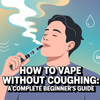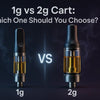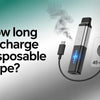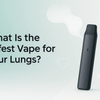What Is the Safest Vape for Your Lungs?
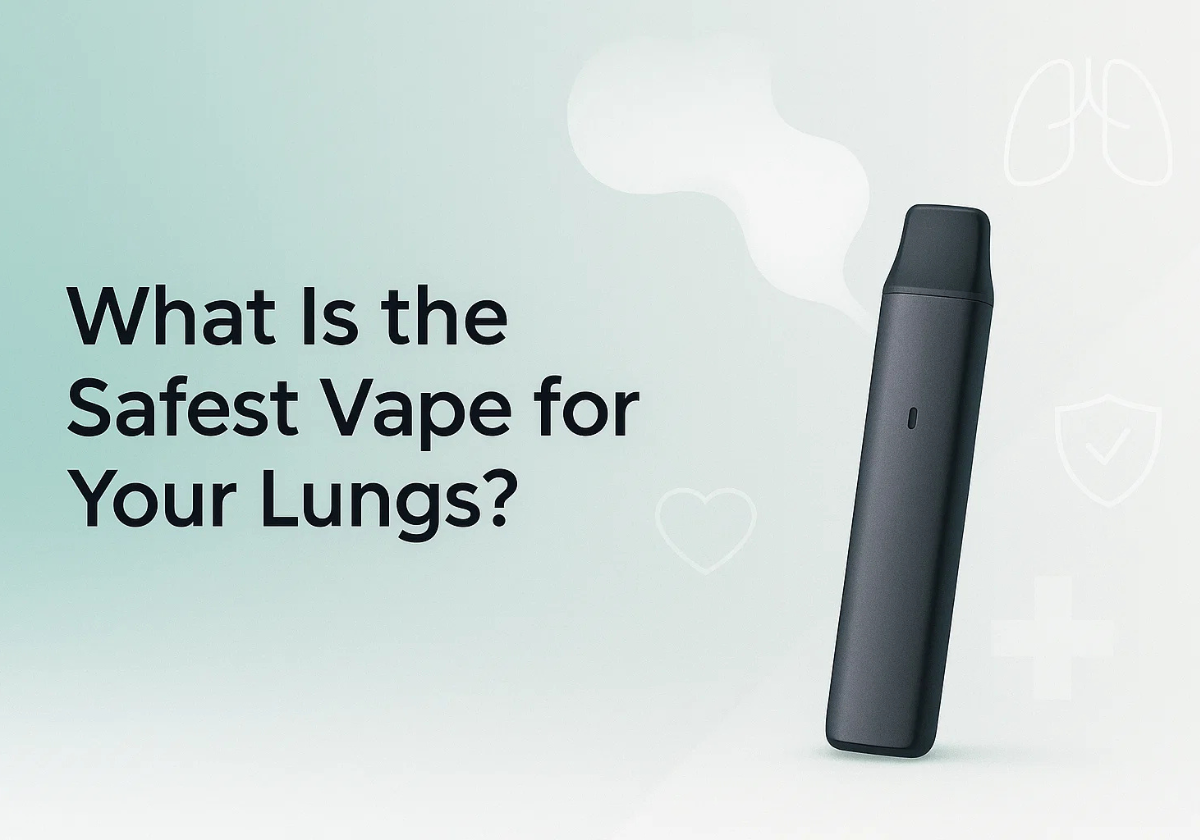
If you're trying to quit smoking or just curious about vaping, you've probably wondered: are some vapes actually safer than others? The short answer is yes—but it's not as simple as picking a brand off the shelf.
Vaping is often marketed as a safer alternative to smoking, and while it does eliminate many of the toxic byproducts of burning tobacco, not all vapes are created equal. Some devices are engineered with better materials, cleaner ingredients, and smarter technology that can genuinely reduce harm to your lungs. Others? They're filled with questionable chemicals, cheap hardware, and zero quality control.
In this guide, we'll walk you through everything you need to know about choosing the safest vape for your lungs—from understanding what's actually in that vapor to spotting red flags in ingredients and devices. Whether you're looking for the healthiest vape brands, trying to figure out if nicotine-free vapes are worth it, or just want to vape without wrecking your respiratory system, you're in the right place.
Understanding Vape Safety — What Really Affects Your Lungs
Before we dive into which vapes are safest, let's talk about what actually happens when you vape—and why it matters for your lung health.
How Vaping Works
Unlike cigarettes, which burn tobacco and create smoke, vapes heat e-liquid until it turns into vapor. This process—called vaporization—happens at much lower temperatures than combustion, which means you're not inhaling the tar, carbon monoxide, and thousands of chemicals produced by burning tobacco.
Here's the basic process: A battery powers a heating element (usually a coil), which heats up the e-liquid stored in a tank or pod. The liquid vaporizes, you inhale it, and exhale a cloud of aerosol that looks like smoke but isn't. Because there's no combustion, vaping is generally considered less harmful than smoking—but that doesn't automatically make it safe.
The quality of that vapor depends heavily on what's in your e-liquid, how hot your device gets, and what materials your coil is made from. Get any of those wrong, and you could be inhaling stuff you definitely don't want in your lungs.
Common Ingredients in Vape Juice
Most e-liquids contain four basic ingredients. Let's break them down:
Propylene Glycol (PG): This is a thin, odorless liquid that carries flavor well and creates that "throat hit" smokers are used to. PG is generally recognized as safe by the FDA for ingestion, but inhaling it long-term? The jury's still out. Some people experience throat irritation or allergic reactions.
Vegetable Glycerin (VG): Thicker and slightly sweet, VG produces those big, billowy clouds. It's considered safer and gentler on the throat than PG, which is why many lung-friendly vape options lean toward higher VG ratios.
Nicotine: The addictive substance from tobacco. While it's not the main culprit behind smoking-related diseases, nicotine does affect your heart rate, blood pressure, and can keep you hooked. Nicotine-free vapes eliminate this risk entirely.
Flavorings: This is where things get dicey. Food-grade flavorings might be safe to eat, but heating and inhaling them is a different story. Some flavorings break down into harmful compounds when heated, and others—like diacetyl—are straight-up dangerous for your lungs.
What Makes a Vape Unsafe
Not all vapes are designed with your health in mind. Here's what can turn a vape from questionable to downright dangerous:
Harmful additives: Cheap or unregulated e-liquids may contain vitamin E acetate, heavy metals, or other toxic chemicals that have no business being near your lungs.
Low-quality hardware: Poorly made coils can release metallic particles. Plastic heating chambers can leach chemicals when heated. If your device is built with subpar materials, you're inhaling more than just vapor.
Counterfeit products: Fake vapes and knock-off e-liquids flood the market, especially online. These products skip safety testing entirely and often contain mystery ingredients.
Overheating: When a coil gets too hot, it doesn't just burn your e-liquid—it can create toxic compounds like formaldehyde. This is why temperature control matters.
Safest Vape Types for Lung Health
So which types of vapes are actually better for your lungs? Let's break down your options.
Nicotine-Free Vapes
If you're not trying to quit smoking and don't have a nicotine addiction, nicotine-free vapes are your safest bet. They eliminate the addictive component and the cardiovascular stress that comes with nicotine use. Your lungs won't have to deal with nicotine's impact on blood vessels and inflammation.
That said, "nicotine-free" doesn't mean "risk-free." You're still inhaling vaporized chemicals, so quality still matters. Look for nicotine-free vapes with clean, lab-tested e-liquids and avoid gimmicky flavors that might contain sketchy additives.
Temperature-Controlled Vapes
Here's something most people don't know: when vape coils overheat, they can break down e-liquid ingredients into toxic compounds—including formaldehyde and acetaldehyde. Temperature-controlled (TC) vapes solve this problem by regulating how hot the coil gets.
TC devices monitor the coil's temperature in real-time and adjust power output to keep it in a safe range. This prevents burning, reduces harsh hits, and significantly lowers your exposure to harmful byproducts. If lung safety is your priority, a temperature-controlled vape is one of the smartest investments you can make.
Refillable vs Disposable Vapes
Both have pros and cons when it comes to safety:
Disposable vapes are convenient—no maintenance, no refilling. But you have zero control over what's inside. Many disposable vapes use lower-quality e-liquids and cheaper hardware. They're also more likely to be counterfeited since they're mass-produced and harder to trace.
Refillable vapes give you control. You choose your e-liquid, replace your coils, and can opt for higher-quality ingredients. The downside? They require regular cleaning and maintenance. Neglect them, and you'll end up inhaling residue and burnt gunk.
For lung health, refillable vapes with reputable e-liquids are generally the safer choice—as long as you're diligent about upkeep.
Ceramic Coil Vapes
Traditional vape coils are made from metal—usually kanthal, stainless steel, or nichrome. While these work fine, they can degrade over time and release tiny metallic particles into your vapor.
Ceramic coils are different. They heat more evenly, last longer, and don't leach metal into your vapor. They also tend to operate at lower temperatures, which means less risk of creating toxic byproducts. If you want a lung-friendly vape option, ceramic coils are a solid upgrade.
Healthiest Vape Brands to Consider
Not all vape companies are created equal. Some prioritize profits over safety, while others invest in research, testing, and transparency.
Top Reputable Vape Brands
While we can't endorse specific products, here's what to look for in the safest vape brands:
FDA-registered manufacturers: Companies that operate under FDA oversight are more likely to follow safety standards and quality control protocols.
Medical-grade vaping devices: Some brands design vapes specifically for harm reduction or therapeutic use (like cannabis patients). These tend to have higher safety standards.
Established brands with third-party testing: Look for companies that publish lab results showing their e-liquids are free from contaminants and accurately labeled.
Transparent ingredient sourcing: The best brands openly share where their ingredients come from and what's in their products—no vague "proprietary blend" nonsense.
What to Look For in a Safe Vape Brand
When you're shopping for healthy vapes or trying to identify the safest disposable vape, keep these criteria in mind:
Lab-tested e-liquids: Independent, third-party lab reports should verify purity and confirm there are no heavy metals, pesticides, or harmful additives.
Transparent ingredient labeling: You should be able to see exactly what's in your vape juice—PG/VG ratio, nicotine content, and specific flavorings.
Quality coil materials: Look for stainless steel, ceramic, or titanium coils. Avoid mystery metals or coils that aren't clearly labeled.
Proper temperature regulation: Devices with adjustable wattage or built-in temperature control offer safer, more consistent vaping.
Ingredients to Avoid in Vapes
Some ingredients have no business being in vape juice. Here's what to watch out for.
Vitamin E Acetate
This oily additive was at the center of the 2019 EVALI outbreak—a wave of serious lung injuries linked to vaping. Vitamin E acetate was commonly used to thicken black-market THC vapes, but when heated and inhaled, it coats the lungs and causes severe inflammation.
Legitimate, regulated vape products shouldn't contain vitamin E acetate, but counterfeit and unregulated products still might. This is why buying from reputable sources matters.
Diacetyl & Artificial Flavorings
Diacetyl is a buttery-flavored chemical that's safe to eat but dangerous to inhale. It's been linked to a condition called bronchiolitis obliterans—better known as "popcorn lung"—which causes scarring and narrowing of the airways.
While many vape companies have removed diacetyl from their recipes, some artificial flavorings still contain it or similar compounds. Stick with brands that explicitly state their e-liquids are diacetyl-free, and be wary of overly complex, candy-like flavors that might hide sketchy additives.
Cheap E-Liquids and Counterfeits
If a deal seems too good to be true, it probably is. Cheap, unbranded e-liquids often cut corners on ingredients and testing. Counterfeit vapes—especially knockoffs of popular brands—can contain anything from pesticides to heavy metals.
Buy from licensed retailers, check for authenticity seals, and avoid random websites or street vendors. Your lungs aren't worth the discount.
Safe Vaping Habits for Healthier Lungs
Even the safest vape won't protect you if you're using it recklessly. Here's how to vape smarter.
Clean Your Vape Regularly
Residue builds up in your tank, coil, and mouthpiece over time. If you don't clean it, you're inhaling burnt gunk and bacteria along with your vapor. Disassemble your device weekly, rinse the tank with warm water, and wipe down the connections. It takes five minutes and makes a huge difference.
Stay Hydrated
Vaping can dry out your mouth and throat, especially if you're using high-PG e-liquids. Dehydration makes irritation worse and can lead to chronic coughing. Drink plenty of water throughout the day—your lungs and throat will thank you.
Take Moderate Puffs
Long, deep drags might give you bigger clouds, but they also stress your lungs and increase your exposure to whatever's in the vapor. Take shorter, gentler puffs and give your lungs time to recover between sessions.
Replace Coils & Pods Regularly
Old, burnt-out coils don't just taste bad—they release impurities and can produce harmful compounds. Replace your coils every 1-2 weeks (or sooner if you notice a burnt taste), and swap out pods according to the manufacturer's recommendations.
Factors to Consider When Choosing a Safe Vape
Not sure where to start? Here are the key factors that separate safe vapes from risky ones.
Open, Closed, or Disposable Vapes?
Open systems let you refill your own e-liquid. This gives you control over ingredients and quality, but requires maintenance and careful selection of e-liquids.
Closed systems use pre-filled pods. They're more convenient and often have better quality control, but you're limited to the manufacturer's flavors and formulations.
Disposable vapes are the easiest option, but also the riskiest. You have no idea what's inside, and many disposables use lower-quality ingredients. If you choose disposables, stick with well-known, reputable brands and avoid ultra-cheap options.
Quality of Coil
The coil is the heart of your vape, and its material matters. Stainless steel, ceramic, and titanium coils are considered the safest options. They resist corrosion, heat evenly, and don't leach harmful particles.
Avoid cheap coils made from unknown metals, and always replace them before they start tasting burnt. The resistance level (measured in ohms) also affects safety—lower resistance means higher heat, which can produce more toxins if not properly controlled.
Heating Chamber
The chamber where your e-liquid is heated should be made from high-quality materials like stainless steel, glass, or ceramic. Cheap plastic chambers can release chemicals when heated, and low-grade metals may leach into your vapor.
Even heating is also crucial. Hotspots in the chamber can burn your e-liquid unevenly, creating harsh vapor and potentially harmful compounds. Look for devices with well-designed, evenly heated chambers.
Safety Features (On/Off Switch, Auto-Shutoff, Anti-Leak Technology)
Modern vapes come with safety features that older models lacked. Here's what to look for:
On/off switch: Prevents accidental firing in your pocket or bag, which can overheat the device and waste battery.
Auto-shutoff: Cuts power after a certain number of seconds to prevent overheating and coil damage.
Short-circuit protection: Shuts down the device if there's an electrical fault.
Anti-leak technology: Keeps e-liquid contained so you're not inhaling raw juice or dealing with messy spills.
Overheat protection: Monitors temperature and shuts down if the device gets too hot.
These features aren't just convenient—they actively protect your lungs by preventing dangerous malfunctions.
FAQs About Vape Safet
What is the safest vape for your lungs?
The safest vape for your lungs is one that uses high-quality, lab-tested e-liquids with minimal additives, features temperature control or ceramic coils, and comes from a reputable, transparent manufacturer. Nicotine-free options with medical-grade materials are generally the safest choice, though no vape is completely risk-free.
Can vaping cause lung disease?
Yes, vaping can cause lung disease, though it's less common than with smoking. Conditions like EVALI (e-cigarette or vaping product use-associated lung injury) have been linked to vaping contaminated products, particularly black-market THC vapes containing vitamin E acetate. Long-term effects are still being studied, but vaping is not without risk.
Are all vapes harmful to my lungs?
Not all vapes are equally harmful, but none are completely harmless. The level of risk depends on what you're vaping, the quality of the device, and how you use it. High-quality, well-maintained vapes with clean ingredients are significantly less harmful than cheap, unregulated products or smoking cigarettes.
What is popcorn lung and how does it relate to vaping?
Popcorn lung (bronchiolitis obliterans) is a serious lung condition caused by inhaling diacetyl, a chemical used in some e-liquid flavorings. It causes scarring and narrowing of the airways, leading to breathing problems. While many reputable vape brands have removed diacetyl, it may still be present in cheap or unregulated products.
How does vaping affect heart health?
Vaping, especially with nicotine, can increase heart rate and blood pressure, and may contribute to cardiovascular problems over time. Nicotine constricts blood vessels and increases the risk of heart disease. Nicotine-free vapes eliminate this risk, though other ingredients may still affect cardiovascular health to a lesser degree.
Are there health risks associated with vaping, even with safe products?
Yes. Even the safest vapes carry some risk. Inhaling any foreign substance into your lungs can cause irritation, inflammation, or long-term damage. We don't yet know the full long-term effects of vaping, as it's a relatively new practice. The safest approach is not to vape at all—but if you do, choose quality products and practice moderation.
What ingredients should I avoid in vape juice?
Avoid vitamin E acetate, diacetyl, artificial sweeteners, heavy metals, and any e-liquids without transparent ingredient labels. Steer clear of ultra-cheap or unbranded products, and be cautious with complex, candy-like flavors that may contain unknown additives. Always buy from reputable sources that provide third-party lab testing.
Who is vaping unsafe for?
Vaping is unsafe for pregnant women, teens and young adults (whose brains are still developing), people with respiratory conditions like asthma or COPD, individuals with heart disease, and anyone who has never smoked or used nicotine. If you don't smoke, don't start vaping—there's no health benefit.
How safe are wellness vapes as an alternative?
Wellness vapes—often marketed as containing vitamins, essential oils, or herbal extracts—are largely unregulated and unproven. There's no solid evidence they offer health benefits, and inhaling oils or vitamins can be harmful. Many "wellness" claims are marketing hype. If you're considering them for health reasons, talk to a doctor first.
Are cannabis vapes safe?
Cannabis vapes carry similar risks to nicotine vapes, with additional concerns about black-market products. The EVALI outbreak was largely linked to illicit THC vapes contaminated with vitamin E acetate. If you use cannabis vapes, buy only from licensed dispensaries with lab-tested products, and avoid homemade or street-purchased cartridges.
Are lung support supplements worth it when vaping?
There's limited evidence that supplements like NAC (N-acetylcysteine), vitamin C, or omega-3s can protect your lungs from vaping-related damage. While they may support general lung health, they're not a magic shield. The best lung protection is reducing or eliminating vaping, not relying on supplements to counteract it.
Are nicotine-free vapes better for you than cigarettes?
Yes, nicotine-free vapes are generally less harmful than cigarettes. Cigarettes produce tar, carbon monoxide, and thousands of toxic chemicals through combustion. Nicotine-free vapes eliminate both the addictive substance and the combustion byproducts. However, "better than cigarettes" doesn't mean "safe"—vaping still carries risks.
What are the risks of e-cigarette aerosol?
E-cigarette aerosol isn't just water vapor—it contains fine particles, volatile organic compounds, heavy metals from coils, and other potentially harmful chemicals. Inhaling this aerosol can cause lung irritation, inflammation, and may contribute to respiratory and cardiovascular problems over time. The smaller the particles, the deeper they penetrate your lungs.
Final Thoughts — Making a Smart Choice
Look, here's the truth: vaping isn't a health product, and it was never meant to be. It's a harm reduction tool for people trying to quit smoking, or a recreational choice that comes with real risks. If you've never smoked, there's zero reason to start vaping. But if you're already vaping or using it to quit cigarettes, you owe it to yourself to do it as safely as possible.
The key is finding balance. You don't have to sacrifice your entire vaping experience to prioritize safety—you just need to be smarter about your choices. That means investing in quality devices instead of grabbing the cheapest disposable at the gas station. It means reading labels, doing a little research, and trusting brands that are transparent about what goes into their products. It means maintaining your device, staying hydrated, and paying attention to how your body responds.
Here's your action plan:
Start with reputable brands that prioritize safety and transparency. Look for companies that publish third-party lab results, use quality materials like ceramic or stainless steel coils, and clearly label their ingredients. If a brand won't tell you what's in their product, walk away.
Choose devices with safety features—temperature control, auto-shutoff, leak protection—and skip the ultra-cheap options that skimp on quality. If you're serious about protecting your lungs, nicotine-free vapes with high VG ratios and minimal additives are your best bet.
Stay informed. Vaping research is constantly evolving, and what we know today might change tomorrow. Follow credible health sources, not just marketing hype or anecdotal Reddit threads. If something sounds too good to be true—like "vitamin vapes" that claim health benefits—it probably is.
And finally, listen to your body. If you're experiencing persistent coughing, chest tightness, shortness of breath, or any respiratory symptoms, take it seriously. Don't ignore warning signs just because vaping is supposed to be "safer than smoking."
The safest vape for your lungs is ultimately the one you don't use—but if you're going to vape anyway, do it right. Your respiratory health isn't something to gamble with, and the choices you make today will affect how your lungs function years down the road.
Be smart. Be selective. And never stop questioning what you're putting into your body.

